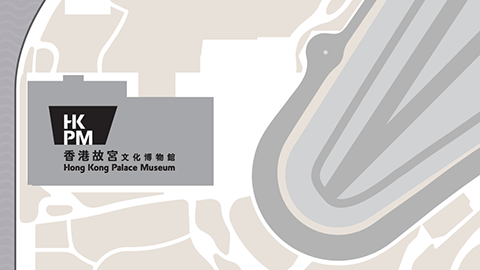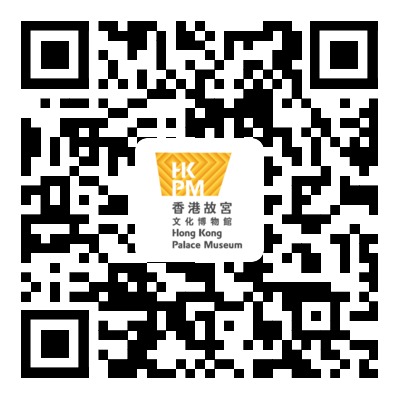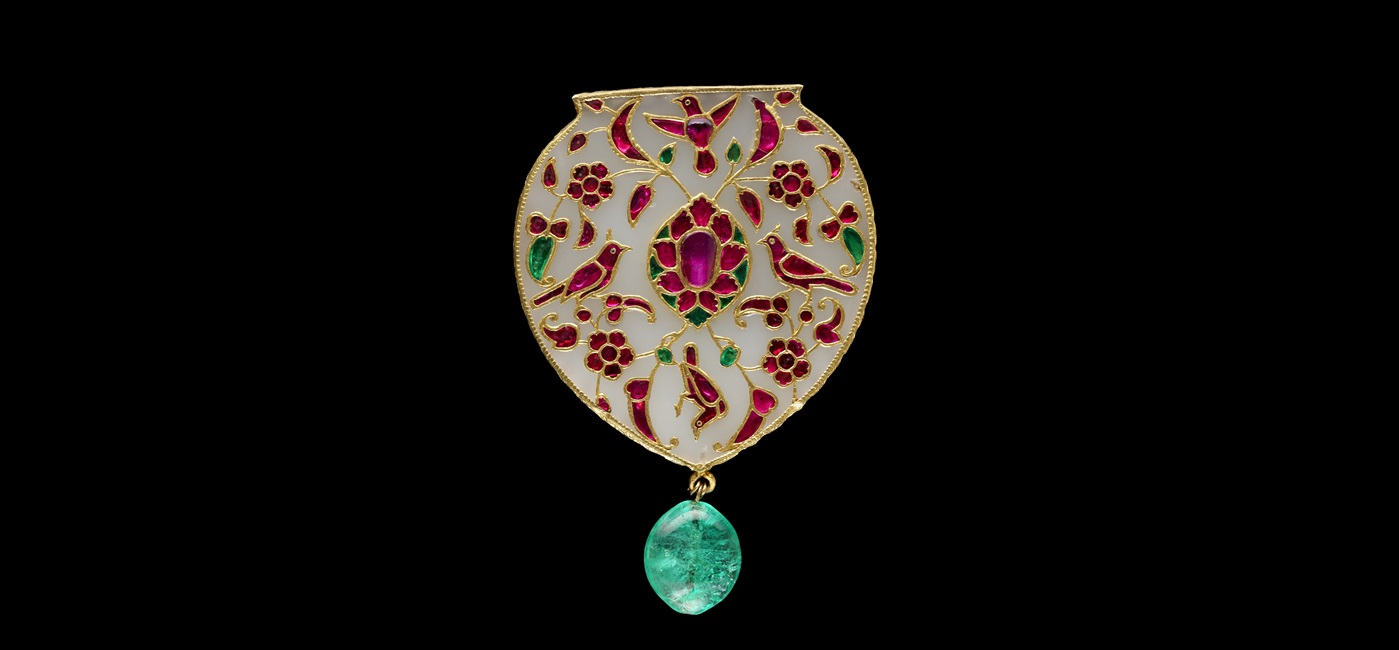The first comprehensive exhibition in Hong Kong dedicated to the pinnacle of Mughal art, celebrating the multicultural artistic styles and extraordinary craftsmanship of the Mughal court
The Hong Kong Palace Museum (HKPM) presents a new special exhibition “The Hong Kong Jockey Club Series: Treasures of the Mughal Court from the Victoria and Albert Museum” (“Treasures of the Mughal Court”), which will be open to the public from 6 August 2025 to 23 February 2026. “Treasures of the Mughal Court” will be Hong Kong’s first comprehensive exhibition dedicated to Mughal art, celebrating the diverse artistic traditions and unparalleled craftsmanship from the “golden age” of the Mughal dynasty (1526–1857) through a display of over 100 precious artefacts. Jointly organised by the Victoria and Albert Museum (V&A) and the HKPM, and solely sponsored by The Hong Kong Jockey Club Charities Trust, this exhibition also marks the first major collaboration between a Hong Kong museum and the V&A, the world’s largest museum of decorative arts and design. Tickets for the exhibition are now available on the West Kowloon Cultural District’s online ticketing platforms and ticketing partners.
The Mughals stand as one of the most influential dynasties in South Asian history. This Muslim, Persian-speaking dynasty began with its first emperor, Babur (r. 1526–1530), who was descended from both Amir Timur (r. 1370–1405), the Central Asian conqueror, and Genghis Khan (r. 1206–1227), the founder of the Mongol dynasties. Babur’s dynasty became known as “Mughal”, the Persian for “Mongol”. At their peak, Mughal territories extended from Kabul in present-day Afghanistan to the borders of the Deccan sultanates in the south of the subcontinent, and from Gujarat in western India to present-day Bangladesh in the east. Between the 1560s and the 1660s, the Mughal dynasty experienced its “golden age”. This century also witnessed the three remarkable emperors, Akbar (r. 1556–1605), his son Jahangir (r. 1605–1627), and his grandson Shah Jahan (r. 1628–1658), who played pivotal roles in shaping Mughal art. They fostered a climate of curiosity and encouraged cultural and artistic exchange across South Asia, China, Iran, and Europe, which culminated in a multifaceted Mughal style. The Mughal dynasty’s enduring contributions to global heritage include its profound influence on art, culture, and architecture, exemplified by the magnificent Taj Mahal commissioned by Shah Jahan, now popularly recognised as one of the new ‘Wonders of the World’. This exhibition not only displays artefacts related to the Taj Mahal but also features an immersive digital installation titled “Taj Mahal: A Love Story in a Majestic Monument”, offering a captivating exploration of the historical and artistic significance of this iconic world heritage monument. Today, architectural forms and floral decorations reminiscent of Shah Jahan’s reign are still widely used throughout South Asia, showcasing the enduring Mughal influence in the region. This impact extends globally, for instance, in the English language the word “mogul”, a homophone of “Mughal”, refers to a person with enormous wealth and power, much like a Mughal emperor.
Furthermore, “Treasures of the Mughal Court” marks a significant collaborative milestone following the signing of a memorandum of understanding between the HKPM and the V&A at the first-ever Hong Kong International Cultural Summit organised by the West Kowloon Cultural District Authority in 2024. A special exhibition on the same theme debuted to great acclaim at the V&A between late 2024 and early 2025, and “Treasures of the Mughal Court” at the HKPM will be its only stop in Asia after its London premiere. Incorporating a fresh curatorial perspective, the HKPM will present masterpieces from both China and South Asia, illuminating the artistic exchange and mutual appreciation of these two great cultures, sparking a unique cultural dialogue. The Mughal and Qing dynasties, both influential powers that reigned in Asia during similar periods, were renowned for their multi-ethnicity and remarkable artistic achievements.
Hong Kong’s first comprehensive exhibition of Mughal art highlights the court’s unparalleled artistic mastery and cross-cultural exchanges
“Treasures of the Mughal Court” presents approximately 100 spectacular loans from the V&A collection, supported by loans from Kuwait, the UK, Hong Kong, and other international collections, ranging from paintings to jewellery, architectural fragments, weaponry, textiles, and ceramics. The Hong Kong Palace Museum, the Chris Hall Collection at the Hong Kong Palace Museum, and the Collection of Mengdiexuan also provide important loans.
The exhibition is presented in three thematic sections: “Founder of the New Era: Emperor Akbar (r. 1556–1605)”, “Explorer of World Treasures: Emperor Jahangir (r. 1605–1627)”, and “Architect of Paradise on Earth: Emperor Shah Jahan (r. 1628–1658)”. Each section examines the extraordinary artistic achievements of the Mughal court during the three emperors’ reigns, offering an in-depth look at the dynasty’s century-long flourishing of art and culture. Exhibition highlights include:
- Floral motifs of the Taj Mahal: The Taj Mahal is a beautiful mausoleum commissioned by Emperor Shah Jahan in memory of his beloved empress, Mumtaz Mahal (1593–1631). Its exterior is richly adorned with floral motifs created using the popular parchin-kari stone inlay technique, where semi-precious stones are intricately embedded into white marble, symbolising the emperor’s never-wilting devotion to his wife. Notably, patterns of blossoms not only decorated the Taj Mahal but also inspired other Mughal artworks during Emperor Shah Jahan’s reign, proclaiming that the dynasty was a utopian garden of paradise. This exhibition features objects adorned with similar floral patterns, such as a marble screen that features a design and carvings closely resembling the screen still in place in the main inner chamber of the Taj Mahal.
- Dish from the Jingdezhen kilns: Emperor Jahangir had a passion for collecting treasures from around the world, including fine porcelains from the imperial kilns in Jingdezhen, China. This yellow-enamel porcelain dish, produced during the Hongzhi period (1488-1505) of the Ming dynasty, exemplifies the typical yellow-glazed porcelain of that period. The Persian inscription on its base indicates that the dish later entered the Mughal imperial collection and was owned by Emperor Jahangir. This rare detail attests to the esteem in which the Mughal court held Chinese imperial porcelain and underscores the thriving cultural and artistic exchanges between South Asia and China at the time.
- Jewellery: Jewellery was not only a symbol of authority but also a testament to artistic excellence in the Mughal court. Wealthy emperors were adorned with opulent jewellery and jewelled weapons that drew inspiration from diverse cultural influences. As a result, South Asian jewellery flourished with exceptional richness and variety, and it influences modern jewellery design to this day. Highlights include a nephrite jade pendant inlaid with rubies and emeralds using the traditional Indian kundan technique, which involves setting gemstones in place using highly refined gold, contributing to the distinctive aesthetic of Mughal jewellery. Another highlight is a thumb ring that elegantly blends European enamelling with South Asian gemstone-setting techniques, demonstrating the Mughal court’s spirit of cultural synthesis and masterful artisanship.
- Jadework: During Emperor Shah Jahan’s reign, Mughal jade artisans continually drew inspiration from international cultures, incorporating motifs such as Chinese gourds, European vegetal motifs and Central Asian animal forms into their works. Their refined craftsmanship produced luxury items from nephrite jade sourced from the Khotan area. The distinctive Mughal style subsequently influenced Chinese imperial art a century later. The Qianlong Emperor (r. 1736–1795) of the Qing dynasty, one of the greatest art collectors and patrons in China, was captivated by Mughal jades. He amassed a vast collection of jadework, commissioned the court artists to emulate the Mughal style, and composed nearly 60 poems in praise of their outstanding craftsmanship over the span of 27 years. This exhibition includes a nephrite jade wine cup in the shape of a petal, carved from a single piece of Khotan jade, showcasing remarkably thin and translucent walls that exemplify the peak of Mughal jade artistry. Another notable piece is a nephrite jade pen box adorned with rubies, emeralds, and diamonds arranged in interlinking floral patterns using the traditional kundan technique, reflecting the refined world of a high-ranking member of the Mughal court.
- Mother-of-pearl inlay: The technique of mother-of-pearl inlay reached its peak during the Ming (1368–1644) and Qing (1644–1911) dynasties and was widely used in furniture decoration, as seen in the altar table with flowers and plants in pots and vases from the HKPM collection. The casket from the V&A features a typical 16th-century design from Gujarat in western India during the Mughal rule and is adorned with mother-of-pearl inlay artistry. Juxtaposing the altar table and the casket shows how Chinese and Mughal artisans adapted mother-of-pearl inlay techniques to their local cultures.
- Paintings of the Mughal court: The exhibition showcases several masterpieces by Mughal court painters, including Emperor Jahangir in a garden and Emperor Akbar being entertained by Azim Khan at Dipalpur in 1571. These paintings provide a rare glimpse into the lives of Mughal emperors. A striking painting of a North American Turkey embodies Emperor Jahangir's passion for exploring the natural world and exemplifies his practice of commissioning court artists to focus on themes of flora and fauna, resulting in remarkable series of plant and animal depictions.
Diverse learning programmes and innovative multimedia elements
To encourage visitors’ exploration of the artistic and cultural exchanges during the Mughal dynasty’s “golden age”, the Museum will offer a variety of learning programmes, including guided tours, audio guides, public lectures, and Arabic calligraphy workshops. The exhibition also incorporates multimedia and interactive elements, allowing visitors to immerse themselves in the world of the Taj Mahal, explore the tastes and personalities of the Mughal emperors, and closely examine exquisite court miniature paintings. Tactile stations will provide hands-on insight into the materials and craftsmanship techniques employed by Mughal artisans.
Regular tickets and summer family packages
“The Hong Kong Jockey Club Series: Treasures of the Mughal Court from the Victoria and Albert Museum” will be open to the public from 6 August 2025 to 23 February 2026 in Gallery 8 of the HKPM. Tickets for this special exhibition, which also grant access to all the thematic exhibitions in Galleries 1–7, are priced at HK$150 for adults and HK$75 for concessions*. Visitors purchasing Full Access Tickets, priced at HK$200 for adults and HK$100 for concessions*, will have access to the thematic exhibitions (Gallery 1–7) and special exhibitions (Gallery 8 and 9). “Wonders of Imperial Carpets: Masterpieces from the Museum of Islamic Art, Doha” is now open in Gallery 9 and will run until 6 October 2025. Tickets are now available for sale or reservation through the West Kowloon Cultural District’s online ticketing platforms and ticketing partners. Please refer to the HKPM website for more information.
In addition, during the period from 1 July to 31 August, the HKPM offers special family packages for visits to its special exhibitions during summer. Visitors purchasing two adult tickets and one child (aged 7 to 11) ticket will enjoy a discount of up to 20%. More details can be found on the “Tickets” page on the HKPM website.
*Concessions are available to children aged 7 to 11, full-time students, seniors aged 60 and above, persons with disabilities (with one companion), and CSSA recipients.
Remarks
About the Hong Kong Palace Museum
Through innovative curatorial approaches, the Hong Kong Palace Museum presents priceless treasures from The Palace Museum along with the finest collections from other world-�renowned institutions. The Museum is also in the process of building its own world-class collection. Opened in 2022, the Museum is a leading institution for the study and appreciation of Chinese art and culture and the promotion of dialogue among world civilisations. The Museum is a collaborative project between the West Kowloon Cultural District Authority and The Palace Museum. The Hong Kong Jockey Club Charities Trust made a donation of HK$3.5 billion for its establishment, as well as some of the annual exhibitions and education programmes in 2023–2031.
Through research, exhibitions, publications, and educational and professional exchange programmes, the Museum builds international partnerships and positions Hong Kong as a global hub for art and culture. A resource that belongs to the local community, the Museum inspires community engagement, fosters dialogue, and promotes creativity and interdisciplinary collaboration.
About the West Kowloon Cultural District (WestK)
WestK is one of the largest and most ambitious cultural hubs in the world and Hong Kong’s new cultural tourism landmark, spanning 40 hectares alongside Victoria Harbour. WestK comprises a mix of landmark arts and cultural facilities, including world-class museums M+ and the Hong Kong Palace Museum, intricately designed performing arts venues the Xiqu Centre and Freespace, the 11-hectare Art Park with a waterfront promenade, and the upcoming WestK Performing Arts Centre.
Hosting over 1,000 exhibitions, performances, programmes, and events each year, WestK provides a vital platform for both emerging and established artists. WestK welcomes more than 10 million visitors each year, evolving as the international cultural brand of Hong Kong and strengthening the city’s strategic role as an East-meets-West centre for international cultural exchange.
https://www.westk.hk
About the Victoria and Albert Museum
The V&A is a family of museums dedicated to the power of creativity – its power to entertain and move, to enrich our lives, open our minds and change the world. V&A celebrates and shares that power through a programme of exhibitions, events, educational and digital experiences, a collection of 2.8 million objects, and through the support for new works and commitment to conservation, research, and sustainable design. Together, it tells a 5,000-year-old story of creativity, helping to advance cultural knowledge everywhere, and inspiring the makers, creators and innovators of today and tomorrow.
https://www.vam.ac.uk









